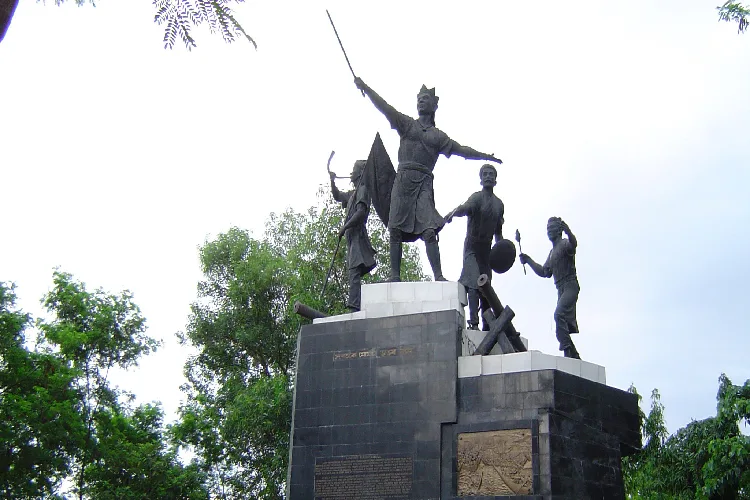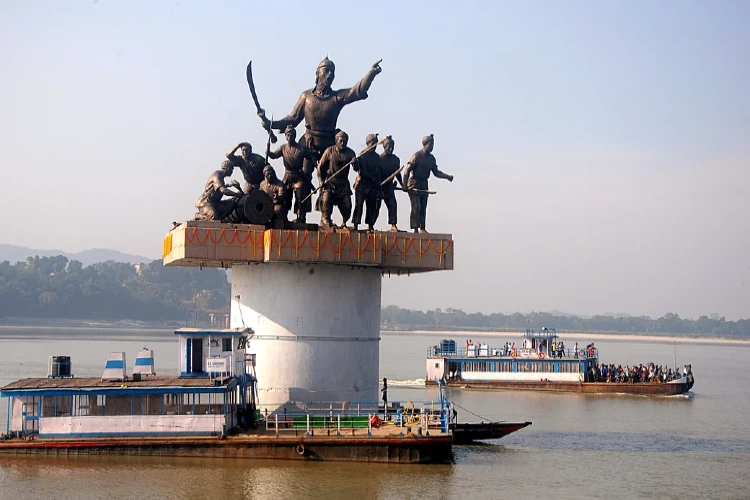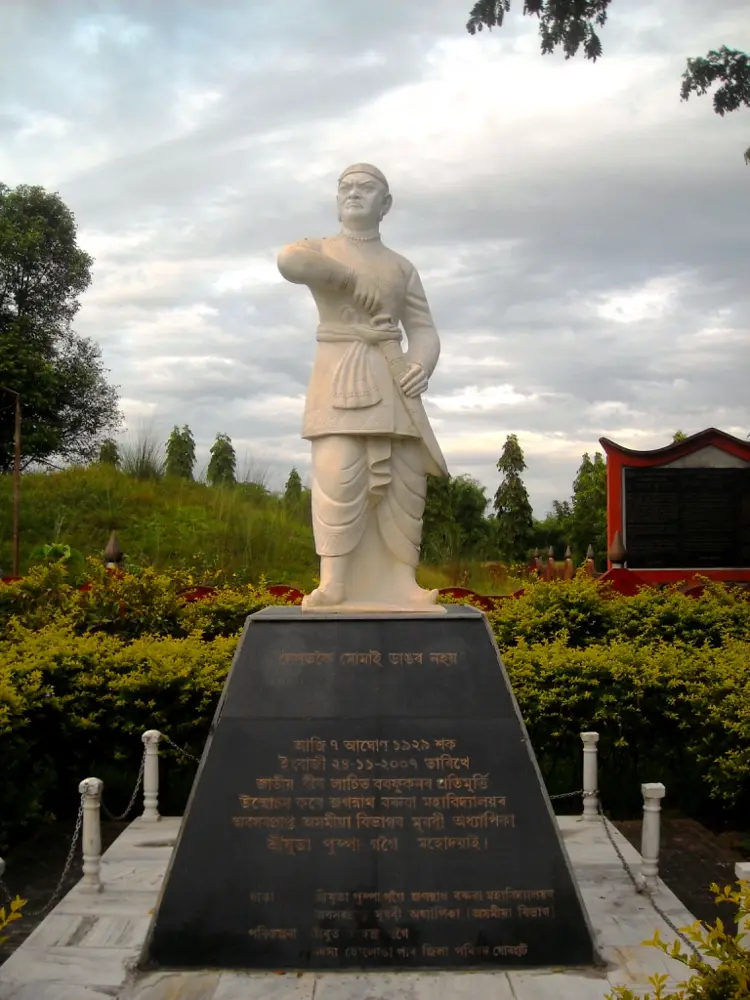Sunil Pawan Baruah
Medieval Indian history presents several outstanding personalities who stood firmly against the Mughal power in Delhi to preserve regional autonomy and cultural independence in different parts of the country. In Northeastern India, Lachit Borphukan, a general of Ahom kingdom in Assam could claim a similar position in the national history. Patriotism and valour of Lachit Borphukan inspire the people of the Brahmaputra valley even today to keep the prestige and honour of their country. Born in a prestigious Ahom family Lachit was destined to perform a heroic deed at a critical time for the cause of his motherland.
He was the youngest son of Momai Tamuli Borbonuah, a high-level minister of the Ahom court, who was responsible for organizing a perfect administrative setup and social system in Assam during the Ahom period. Naturally, young Lachit got inspiration from the life of his illustrious father and built his career on that line to restore the liberty of the Ahom kingdom that was threatened by powerful foreign invasion coming from the west.
Ahom kingdom was established in Upper Assam in the first half of the 13th century and extended to others of the state within a short time.
Lachit Borphukan memorial in Bramhaputra
Muslim invasion from the west also started at the same time and continued for about four hundred years till the end of the seventeenth century.
However, it failed to impose any permanent political impact in the region, although a new socio-cultural contact was established with the world.
At the first half of the 16th century, Islamic power in Bengal had again started a military conflict with the Ahom kingdom but Ahoms expelled them up to the river Korotowa of North Bengal.
Later, taking the advantage of the weakness of the Koach kingdom in Western Assam, Mughal emperor Jahangir (1605 1627) annexed Koach-Hajo or Kamrup region to the Mughal empire. The occupation of Koach-Hajo or Kamrup by the Mughal army led to the possibility of future Ahom Mughal conflict in Assam. It was started in 1616 and continued for about 50 years till the famous battle of Saraight (1671).
Foreign invasion under Mirzumla, the powerful Mughal General in the year 1662 63 brought disaster to the Ahom kingdom and even the capital Gargaon was conquered by invading army. But Mirzumla had to give up the occupation of Gargaon soon for being unable to face the natural calamities and sporadic attacks of Ahom soldiers. He returned by signing the treaty of Ghilajari in January 1663 that compelled Ahoms to cede lower Assam including Guwahati and made the Ahom king a tributary ruler under the Mughal Empire.
Jayadhaj Singha (1648-1663) the defeated Ahom ruler returned to capital and with a broken heart died soon and was succeeded by his cousin Chakradhaj Singha (1663-69) with his accession to the throne the Ahom Mughal relation had entered into a new phase. He refused to obey the alien rule and decided to take quick action against the Mughal army to expel them from lower Assam. However, the wise prime minister Atan Buragohain detached him from taking hasty steps and advised to prepare silently for a long battle.
Accordingly for about two years, elaborate preparation was made to rescue Guwahati as well as the Kamrup region. Incidentally during that time the great Maratha hero Shivaji successfully halted the Mughal onslaught in South India and it inspired the Ahom army in Eastern India.
A statue of Lachit Borpukhan
Based on this assignment, he very often attended the high-level meeting of the ministers and thus got his first diplomatic lesson. Later, Lachit was associated in successive posts like Ghora Baruah, Dolakashoria Baruah, and Simaluguri Phukan and performed every with a high sense of responsibility and utmost devotion. Dolakashoria Baruah accompanied the king when he moved into a public place on a royal palanquin surrounded by security persons. The post was equivalent to the present-day police chief and it enhanced the prestige of young Lachit.
Even he earned the experience of the battlefield in Dikhowmukh at the time of the invasion of Mirzumla.
On April 20, 1667, Borphukan had left the capital after performing due rituals in his new mission. Within two months the mission was completed and the Mughal Army in Guwahati was defeated. Ahom army had driven the Mughals up to the Manah river, the border of the Ahom kingdom. After the restoration of the prestige of Ahoms Guwahati was reorganized as a military base to defend Lower Assam.
Lachit Borphukan established his military headquarters at Itakhuli in the South Bank of the river Brahmaputra, at the heart of the modern Guwahati city, and remained alert to repulse any possible Mughal attack.
Emperor Aurangzeb (1658-1707) received the news of the Mughal defeat with shock and decided to send a new army to recapture Guwahati. Raja Ram Singha, the powerful Hindu general of the Mughal Empire was appointed as the head of the Army and he was assisted by several Mughal Generals. It was a huge army consisting of artillery, cavalry, and a company of field guns.
To make it more perfect thousand hunting dogs were also added to detect the army position, on the other hand, some religious preceptors accompanied the army to counteract the much-circulated fear about the magical power of the local people of Assam. Sikh Guru Tegbahadur also joined them from Patna. Mughal army had arrived in Assam at the beginning of the year 1669 and prepared for the final battle from the north bank of the Brahmaputra. However, in 1669 and 1670 fighting and proposal for peace continued simultaneously. In fact, during this time Ram Singha had stopped military campaign practically from October to March to avoid guerilla warfare started by Ahoms. At the same time invading Mughal army tried to damage the confidence of Ahoms by circulating rumours about the integrity and leadership of Lachit Borphukan.
But everything failed to the foresightedness of the Ahom general. Despite traditional belief, he was not guided by superstition alone and his self-confidence always inspired him to be practical in the hour of need. On the battlefield, they got immense power even to issue the death penalty for the negligence of duty.
Meanwhile, an incident occurs the story of which spread like wildfire among soldiers. It was said that Borphukan killed his maternal uncle, as being the in charge, he showed lethargy in constructing a rampart that was needed to be completed within a night. Ahoms found it difficult in facing the cavalry attack of Mughals and Lachit was very much aware of this position of his army.
However, despite his unwillingness once Ahom army had to face the Mughals in the open battle of Alabol mountain. As a result, ten thousand Ahomi soldiers had lost in a single day and it became a good lesson for future battles. Meanwhile, both the parties tried to demonstrate their power and strength by sending symbolic presents.

Finally, realizing the failure of prospects of peace and receiving an order from the emperor Ram Singha decided to take direct action for entering Guwahati and perhaps the news of the severe illness of Lachit Borphukan prompted him to do so.
By crossing the river Brahmaputra on march 1671 the Mughals tried to enter Guwahati between Itakhuli (Sukreswar) and Nilachal mountain after finding some fault in the side rampart. But as it failed the Mughal army changed the direction towards the enemy position of Asawaklanta at North Bank. It created panic among Ahoms and fearing imminent defeat most of them started sailing their boats towards the east.
At this critical moment Lachit Borphukan, who was suffering from illness, observed the battle scene from his camp and unable to bear the prospect of defeat ordered to move to the boat with a bed in the direction of the Mughal position.
As the Ahom soldiers noticed this unbelievable scene they quickly plunged into the battle and surrounded Mughals.
Meanwhile, the big guns from the mountain also started to target the Mughal army. After a decisive battle Mughal army under Raja Ram Singha was completely defeated and started to flee towards the west and finally left Assam on April 5, 1671.
In this way, the historic battle of Saraight was ended by restoring the sovereignty of Ahoms kingdom in Assam and finally closing the Ahom Mughal conflict in eastern India with much humiliation to the Mughal empire.
Dr S.K. Bhuyan, a noted historian had compared the battle of Saraighat with the battle of Trafalgar (1804), where Lord Nelson defended the glory of England by defeating the French army of Napoleon Bonapart. However, like Lord Nelson Lachit Borphukan also did not live to enjoy victory and died soon after the battle. Raja Ram Singha in his return journey highly praised the morals of Assamese soldiers, the leadership of Lachi Borphukan, and Prime Minister Aton Buragohain. Especially he was very much Impressed at the versatile quality of Assamese soldiers on the battlefield. Since the time of the battle of Saraighat the story about patriotism and courage of Assamese people spread to the rest of the country through an eminent person like Guru Teg Bahadur, who accompanied the Mughal army. It indirectly contributed to the downfall of the Mughal empire as other regional powers also got the inspiration to stand against Mughal after Saraighat.
(Writer taught Modern History in B.Borooah College in Guwahati)
.webp)



